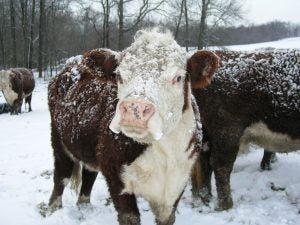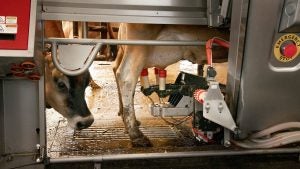Confession. Before I started blogging, I didn’t know a whole lot about animal agriculture. My family grows crops — fruits, vegetables, cash crops. We’ve never had farm animals, aside from the family dog and some barn cats, of course. Don’t get me wrong: I know a lot of farmers with animals. And they’re all really awesome people. So I was never under any delusion that the entire industry was evil or bad.
It wasn’t until 2013, when I was halfway around the world visiting a Ukrainian dairy farm, that I realized just how awesome animal agriculture was. When we returned home, I was eager to really start listening and learning. And there were plenty of animal farmers on social media offering what I was looking for.
So after seven years of engaging, here are 5 big things this crop-farmer’s daughter has learned about animal agriculture:
1. It’s a different lifestyle.
Crops are a different time commitment than animals. We usually have “busy seasons” on our family farm. Spring and fall often involve 12-hour days, seven-days a week as we slowly and methodically cover each acre. When we had our roadside stand, the summer months were spent meticulously caring for, harvesting, and selling fresh produce.
But animals require care each day, including Christmas morning. While animal farmers might not spend 12 hours each day in the barn, they have to go into work on a daily basis. Want a vacation? You’ll have to get someone to cover the chores. I’m not saying it’s easier or harder work, or even more or less work, but it is different.
2. Environmental stewardship is a big deal.
Unfortunately, animal agriculture has a (undeserved) reputation for being super environmentally destructive. But my animal-farming friends care just as much about being faithful stewards as their crop-growing counterparts. It just looks different and there are different concerns. Yet I’ve also seen innovative ways to turn problems into solutions — like using manure as a source of energy.

3. Animal rights aren’t the same as animal care.
This is tricky to explain to people. Sometimes practices seem like they violate an animal’s “rights.” But they’re actually part of good animal husbandry. That is, the science of caring and breeding farm animals.
For example, activists have made a big deal about the use of farrowing crates for sows. The pigs are put into these narrow spaces after giving birth. On the surface, the outrage even seems reasonable — the momma pig can’t move around! But, in reality, the practice protects the little piglets. They can easily be crushed by their mother — who likely weighs hundreds of pounds — while nursing. So the crates can be part of good animal husbandry, even if it violates the sow’s so-called rights.
4. Vegan attacks are scary.
I’ll never forget the evening I assisted a friend whose social-media accounts were being attacked by a group of vegans. Apparently, her post was shared in a group that had thousands of members. Those members then decided to express their very ugly feelings en mass.
She asked me to help delete the comments and ban people. It was insane. “You’re a murderer!” “You rape cows!” “You own slaves!” “I’m going to come steal your kids and see how you like it!” It was beyond anything I was used to.

5. Technology can help care for animals.
It’s easier to understand how technology can help us grow crops more efficiently and effectively. But it may seem a little more obscure how it can do the same for raising animals.
Yet it does! Dairy farms are utilizing automatic milkers. Researchers are developing genetically modified animals that don’t grow dangerous horns. Biometric sensors and GPS allow for better monitoring of farm animals. Technology is also revolutionizing animal agriculture.
I’ll take this moment to thank all the animal farmers who share their story on social media. It’s been fascinating to follow along, continue learning, and gain a deeper appreciation of your work!
Amanda Zaluckyj blogs under the name The Farmer’s Daughter USA. Her goal is to promote farmers and tackle the misinformation swirling around the U.S. food industry.



